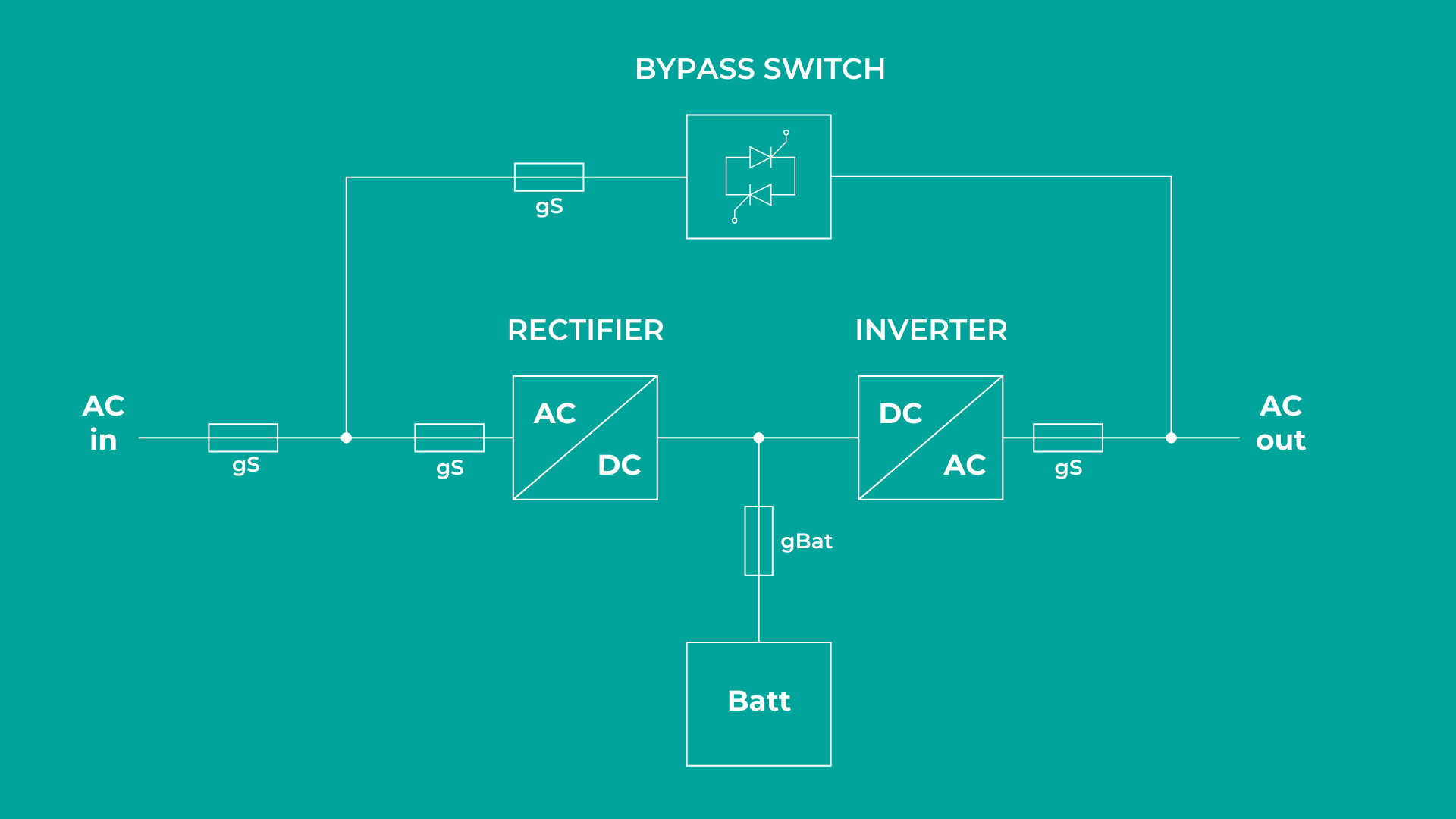Fuse Protection for Battery Storage and UPS Systems: A Technical Guide
Modern energy systems—combining battery storage, rectifiers, inverters, and bypass circuits—are at the heart of the global transition to sustainable, reliable power. In this blog, we explore where and why these systems are used, their key advantages, and the critical role of gS and gBat fuses. We’ll also compare these advanced fuse types with other options, providing technical insights for electrical engineers.

🔋 Where Are These Systems Used?
- Commercial and Industrial (C&I) Facilities: To manage peak demand, provide backup power, and enable participation in grid services.
- Renewable Integration: To store excess solar or wind energy and dispatch it when needed, smoothing out supply fluctuations.
- Critical Infrastructure: Hospitals, data centers, and telecoms use these systems for uninterruptible power supply (UPS) and high reliability.
- Microgrids and Off-Grid Installations: Allow seamless transfer between on-grid and off-grid operation, maximizing energy independence.
⚙️ Why This Architecture?
- Rectifier: Converts AC grid power to DC for battery charging.
- Battery: Stores energy for later use.
- Inverter: Converts stored DC back to AC for loads.
- Bypass Switch: Enables maintenance or fault isolation without interrupting supply.
📈 Key Technical and Operational Benefits
- Grid Flexibility: Store energy during low-demand or low-cost periods, discharge during peaks—reducing energy bills and grid stress.
- Reliability: Bypass circuits and smart controls ensure uninterrupted supply even during component faults or maintenance.
- Scalability: Modular solutions can range from a few kW to multi-MW, supporting both small businesses and utility-scale deployments.
- Efficiency: State-of-the-art inverters achieve up to 98.5% efficiency, minimizing losses.
- Environmental Impact: Supports renewable integration, reduces fossil fuel reliance, and cuts carbon emissions.
Fun fact: The global BESS market is projected to hit $35 billion by 2030—but only if we can keep them up and running.
⚠️ Why Fuse Selection Matters
The Good: Proper fusing slashed BESS failure rates by 97% between 2018–2023.
The Ugly: 65% of BESS failures stem from integration/operation flaws, not cells.
Translation: Skimp on fuse coordination, and you’re playing Russian roulette with your ROI.
Battery Energy Storage Systems (BESS) are critical for grid stability and renewable integration, but their high energy density and complex architecture demand robust protection. gS (semiconductor protection) and gBat (battery-specific) fuses are engineered to address these challenges, offering tailored safety enhancements.
🛡️ gS Fuses: For Power Electronics Protection
- Application: Inverters, rectifiers, and static switches in BESS.
- Ultra-Fast Fault Clearing: Operate ≤10 ms during short circuits, minimizing energy let-through to protect IGBTs, MOSFETs, and thyristors.
- Full-Range Protection: Guard against overloads and short circuits, eliminating the need for backup devices.
- Low Power Dissipation: Reduces heat in enclosures, critical for thermal management.
- Coordination: Ensures selective tripping—isolates faults without taking down the whole system.
Data Point: High-speed fuses like gS reduce peak let-through current by 90% compared to conventional fuses, cutting semiconductor failure rates by 75%.
| Feature | gS Fuse | gR Fuse | aR Fuse |
|---|---|---|---|
| Protection | Full-range (OL + SC) | Full-range | Short-circuit only |
| I²t Let-Through | Ultra-low (~10% of aR) | Moderate | High |
| Dissipation | 15% lower than gR | Standard | High |
| Best For | UPS inverters, rectifiers | Legacy systems | Cheap, low-risk apps |
⚡ Why gS?
98.5% inverter efficiency stays intact because gS fuses don’t cook your IGBTs. || Matches VSG-controlled inverters’ <10 ms response to faults.
🔋 gBat Fuses: For Battery Rack Protection
- Application: Battery modules, racks, and DC busbars.
- High Breaking Capacity: Interrupt fault currents up to 200 kA at 1500 V DC.
- DC-Optimized Design: Built for arc suppression—minimizes fire risk from battery faults.
- Cycling Resilience: Handles frequent charging/discharging without degradation.
- Low Watt Loss: ≤1.5 W per fuse—great for enclosed battery systems.
Data Point: gBat fuses compliant with IEC 60269-7 helped reduce BESS incidents by 97% since 2018.
| Feature | gBat Fuse | HRC Fuse |
|---|---|---|
| Voltage | Up to 1500 V DC | Up to 1000 V DC |
| Breaking Capacity | 150–250 kA | 50–100 kA |
| Standards | IEC 60269-7 | General purpose |
| Thermal Resilience | Built for Li-ion cycling | Generic |
💡 Why gBat?
Survives 100,000+ charge cycles without breaking a sweat. || ETI’s gBat series reduces downtime by 7% via faster fault quenching.
🧠 Integrated Safety Strategy
A comprehensive BESS protection system combines:
- gS fuses for inverters/rectifiers.
- gBat fuses for battery racks and DC busbars.
- Ground fault monitoring (e.g., IMDs) for early detection.
Example: In a 1500 V DC BESS, gBat fuses isolate a faulty battery module within 2 ms, while gS fuses clear inverter faults before IGBTs exceed their ratings.
🚨 Fuse Failures in the Wild: A Cautionary Table
| Scenario | Wrong Fuse | gS/gBat Solution |
|---|---|---|
| Inverter Short | aR fuse melts IGBTs | gS clears fault in 2 ms |
| Battery Thermal Runaway | HRC fuse arcs | gBat interrupts 150 kA |
| Bypass Switch Fault | Generic fuse cascades outage | Coordinated gS/gBat isolates fault |
🔑 Key Takeaways
- gS fuses outperform gR and aR in dissipation and full-range protection.
- gBat fuses are the gold standard for high-voltage, high-cycling battery protection.
- Lower heat = longer life. Ideal for compact BESS and UPS installations.
- General-purpose fuses risk overheating and inadequate protection in these roles.
✅ Conclusion
For electrical engineers designing or maintaining advanced battery storage and UPS systems, gS and gBat fuses are essential. These fuses deliver the fast, full-range protection that modern equipment demands, outclassing legacy fuse options in every key metric.
📌 Ready to Optimize Your Protection?
- Explore our full range of gS and gBat fuses
- Use the ETIFUSE Tool to compare and select the right fuse for your system.
Stay safe. Stay efficient. Stay ahead with ETI.
Data sources: EPRI, IEC.
